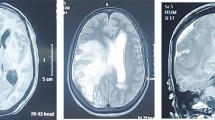Background:
For acoustic neuromas, stereotactic radiotherapy (radiosurgery or stereotactic fractionated radiotherapy) has been established as an important alternative to microsurgery. In most cases initial symptoms are slow progression of unilateral hearing loss, tinnitus or vertigo or acute hearing loss with vertigo. MRI scan shows a contrast-enhancing tumor within the inner auditory channel. If the patient undergoes primary radiotherapy, diagnosis is usually not verified histologically. Therefore, careful evaluation of the medical history is mandatory despite a typical appearance on the MRI scan. If medical history does not match with acoustic neuroma, further diagnostics are necessary to rule out infectious disease or carcinomatous meningitis.
Case Report:
Two patients with hearing loss, vertigo and the diagnosis of acoustic neuromas by MRI scan were referred for radiotherapy. In both cases the symptoms progressed very rapidly, not typical of acoustic neuromas, and in both patients repeated liquor puncture finally revealed carcinomatous meningitis. One patient died during therapy; in the second patient intrathecal chemotherapy and additional radiotherapy of the skull base led to partial remission continuing for several months.
Conclusion:
Before primary radiotherapy of small intrameatal lesions diagnosis must be reassessed carefully. This is especially true for bilateral lesions suspicious for acoustic neuromas and rapid progression and persistence of clinical symptoms where carcinomatous meningitis has to be taken into account.
Hintergrund:
Bei der Behandlung von Akustikusneurinomen stellt die stereotaktische Strahlentherapie (Radiochirurgie oder stereotaktische fraktionierte Strahlentherapie) eine wichtige Alternative zur Mikrochirurgie dar. In den meisten Fällen wird die Diagnose aufgrund einer langsam zunehmenden Hörminderung, einer Vertigo, eines Tinnitus oder eines Hörsturzes gestellt. Die Kernspintomographie zeigt eine kontrastmittelaufnehmende Raumforderung im Meatus acusticus internus. Bei Durchführung einer primären Strahlentherapie kommt es nicht zur histologischen Sicherung der Diagnose. Es muss daher auch bei einem typischen Bild in der Kernspintomographie eine gründliche Anamnese erhoben werden. Falls der Krankheitsverlauf nicht zur Diagnose von Akustikusneurinomen passt, ist die Durchführung weiterer Diagnostik notwendig, um eine Meningeosis carcinomatosa auszuschließen.
Fallbericht:
Es werden zwei Patienten mit Hörverlust und Schwindel beschrieben, welche mit der kernspintomographisch gestellten Diagnose Akustikusneurinom zur Strahlentherapie vorgestellt wurden (Abbildungen 1 und 2). In beiden Fällen waren die Symptome sehr rasch progredient und persistierten über längere Zeit, beides untypisch für das Vorliegen eines Akustikusneurinoms. Die wiederholte Liquorpunktion führte in beiden Fällen zur Diagnose Meningeosis carcinomatosa. Ein Patient verstarb noch während der Therapie; bei dem zweiten Patienten konnte durch intrathekale Chemotherapie und anschließende Strahlentherapie der Schädelbasis eine wenige Monate anhaltende partielle Remission erzielt werden (Abbildung 3).
Schlussfolgerung:
Vor Beginn einer primären Strahlentherapie von kleinen intrameatalen Läsionen (mit Verdacht auf Akustikusneurinom) muss die Diagnose sorgfältig überprüft werden. Insbesondere bei beidseitigen Raumforderungen und rasch progredienter sowie persistierender klinischer Symptomatik muss an die Differentialdiagnose Meningeosis carcinomatosa gedacht werden.
Similar content being viewed by others
Author information
Authors and Affiliations
Corresponding author
Rights and permissions
About this article
Cite this article
Astner, S.T., Nieder, C., Stock, K. et al. Carcinomatous Meningitis Appearing as Acoustic Neuromas. Strahlenther Onkol 183, 279–283 (2007). https://doi.org/10.1007/s00066-007-1615-3
Received:
Revised:
Issue Date:
DOI: https://doi.org/10.1007/s00066-007-1615-3
Key Words:
- Acoustic neuroma
- Bilateral acoustic neuroma
- Hearing loss
- Carcinomatous meningitis
- Stereotactic radiotherapy
- Radiosurgery




